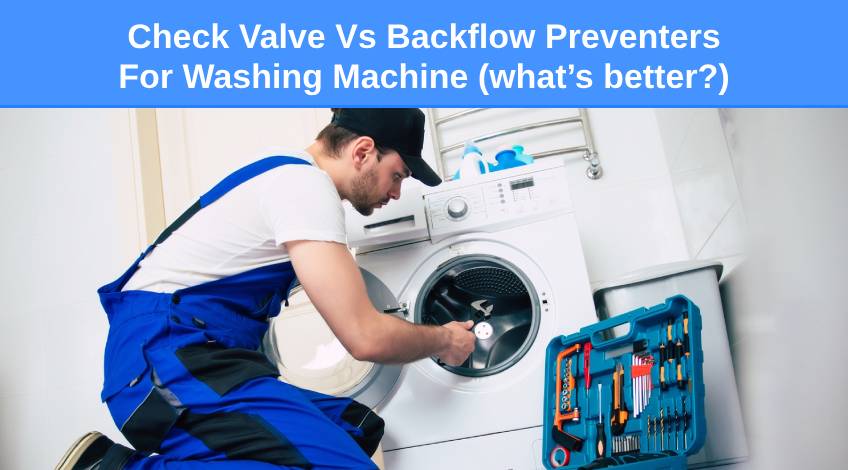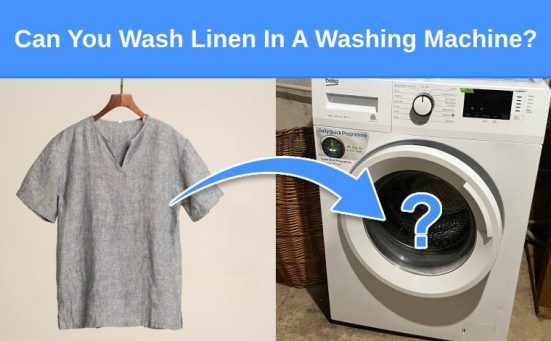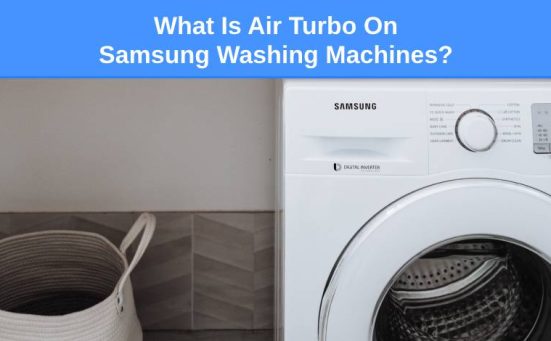
Check Valve Vs Backflow Preventers For Washing Machine (what’s better?)
Nobody wants their water supply contaminated by dirty water. Which is why it’s important to protect your supply by using a check valve on your washing machine to prevent backflow.
But what is a backflow preventer? And is it the same as a check valve? If you’re confused about these plumbing parts and wonder whether you need one (or both), keep reading.
In this article I explain the functions of the backflow preventer and the check valve and compare their uses. As well as answering a number of other related questions along the way.
What’s The Difference Between Backflow Preventers & Check Valves?

Backflow preventers and check valves have similar functions but are distinctly different devices.
Backflow Preventers
The function of a backflow preventer is to stop water from flowing in the wrong direction. In other words, it prevents contaminated water from flowing into a source of freshwater. The backflow preventer is installed at points of cross connection like where water enters the home or commercial building.
Or where the water supply attaches to washing machines (or dishwashers). You will need to check with your local authority for specific regulations regarding the placement of backflow preventers.
A backflow preventer allows a great deal of protection due to their multiple safety features. For example, the double check valve assembly which includes two check valves and an atmospheric vent for added protection as well as a back up valve in case the system fails.
All of which work together to protect the water supply from contamination due to backflow.
Check Valves
In a similar way to a backflow preventer, a check valve stops anything flowing through it in the opposite direction. So any water that remains in the pipe and goes stale won’t be able to enter the drinking water supply.
However, a check valve doesn’t present the same level of protection that a backflow preventer can.
Check valves are not really designed to protect water supplies or more specifically drinking water. If a foreign particle were to enter a check valve, there’s a good chance that the check valve would be blocked or stuck in the open position.
Then there’s the possibility of water hammer if the valve closes too quickly. Water hammer or hydraulic shock as it is also known, happens when the water is forced to stop mid flow or change direction.
The sudden change of movement in the water causes a surge of pressure that causes a wave through the pipework running in both directions. The name comes from the effect of that pressure banging through the pipes before the pressure dissipates.
This can lead to damage to the pipes and potential damage to the valve and in some cases the appliance.
Check Valve Vs Backflow Preventer
Let’s take a brief look at the main differences between these two similar pieces of kit;
| Check Valve | Backflow Preventer | |
|---|---|---|
| Main Usage | Prevents fluid from flowing through it in the wrong direction | Prevents contaminated water from entering drinking water sources |
| What It’s Used For | Sewer systems,air lines, sump pumps, aquariums, etc | Protects drinking water |
| Level Of Protection | One level of protection | Multiple levels of protection |
| Where It’s Fitted | Wherever backflow can cause damage to part of the system | Wherever drinking water enters the system like from the water authority pipes into home plumbing |
| How Do Costs Compare | Costs 2 to 3 times less than a backflow preventer | Up to 3 times as expensive as a check valve |
Does A Washing Machine Need A Check Valve Fitted?
Now we have a better idea of what a check valve does and how it works, you’re probably wondering whether you need to install one or not. The best way to form a definite opinion on that is to look at the pros & cons.
What Are The Advantages Of Fitting A Check Valve?
The main pros of fitting a check valve include;
- Backflow Prevention
Installing a check valve prevents waste water from flowing back into your washing machine. - Protection For The Pump & Compressor
As there is no chance of water surging back into the washer, the pump and compressor are protected from potential damage. - Extra Level Of Safety
This helps protect your washing machine from any damage due to backflow which gives you an extra level of safety from flooding. - Guaranteed Clean Laundry
As the check valve prevents dirty water from returning to your washing machine, it ensures the laundry gets clean and stays clean. - Helps Prevent Water Hammer
Assuming you have installed a check valve with a quick closing process, it will prevent water hammer from occurring.
What Are The Disadvantages Of Fitting A Check Valve?
The main cons of fitting a check valve include;
- Impossible To Inspect
Once the check valve has been installed, it is impossible to check on its condition. You can’t tell whether it’s open, closed or broken. - Can Cause Water Hammer
Unless you have installed a quick closing check valve, your drainage system could experience a water hammer which can be potentially expensive to repair. - Can Only Be Used In An Enclosed System
A Check valve cannot be used in an open system, it is only suitable for an enclosed system. - Possibility Of Reverse Flow
If you fit the check valve incorrectly or fit the wrong size check valve, there’s always the potential for the waste water to reverse flow. It is vitally important that you fit the correct type and size of check valve. Or get a plumber to fit it for you.
Is It Worth Fitting A Check Valve On A Washing Machine?
As you can see from the pros & cons, there are significant good and bad points connected with a check valve. And you’ll need to consider these points carefully before making a decision.
As you can see if fitted incorrectly, a check valve can cause water hammer or reverse flow and you can’t check on the integrity of the valve once fitted.
However, if fitted correctly, it will prevent waste water backflow, protect the pump and compressor on your washer and prevent water hammer from happening. For these reasons I recommend Installing a check valve on your washing machine.
You can purchase a check valve for your washing machine online. Here are a few common ones;
- Samsung DC62-00299A
- SHYNE Premium 3/4 Inch Non Return Check Valve
- Gray Non Return Valve
- Non Return Valve in-Line
- Vioks pro water stop
What Types Of Check Valves Are Available For Washing Machines?

There are several different types of check valves available for washing machines which include;
Swing Check Valves
Swing check valves are non return valves that are self actuating and consist of a swing disc attached to the valve. This disc swings back into position to prevent reverse water flow.
For a swing check valve to be effective, the disc needs to be thick enough and strong enough to take the heavy force of any back flowing water.
These types of check valves are often used in areas where a water hammer is a real possibility.
Tilting Check Valves
Instead of having a swing disc, tilting check valves have a disc that tilts to allow water to flow through them. Once the water has passed through the tilting check valve, the disc tilts back to its original position preventing any back flow from returning through the valve.
The downside to this type of check valve is the fact that they are nowhere near as robust as the swing check valves.
Folding Disc Check Valves
Folding disc check valves also known as double disc, dual, split disc or butterfly check valves open into half at the centreline as water flows forwards.
If the water tries to flow backwards, the valve halves to seal the pipe effectively preventing any backflow. They work in the same way that a butterfly’s wings work.
Ball Check Valves
Ball check valves work using a ball-like gate that opens to allow water to leave but completely blocks the pipe when water tries to flow in the opposite way.
The ball works by lifting when the flow of water creates high pressure and as the pressure decreases, the ball returns to its original position where it forms a tight seal.
Diaphragm Check Valves
These check valves have a C-shaped disc that sits in the pipe and opens as waste water flows out then closes fully to prevent backflow.
Pneumatic Check Valves
Pneumatic or air check valves let air in which then creates a seal to prevent backflow. Mainly used in circuits or systems that only require one way air flow.
Silent Check Valves
Silent check valves, also known as poppet check valves, work by closing very quickly as soon as water flows through them. This immediately prevents backflow and as such, silent check valves are the best choice for preventing water hammers.
How To Install A Check Valve On A Washing Machine

Even though there are several different types of check valves available to buy, they all have the same installation process for washing machines.
What You Will Need:
- Check Valve
- Flexible Hose
- Pipe Cutter
- Silicone Sealant
What To Do:
- Disconnect the power and water supply to your washing machine
- Check the waste pipe for any leaks, obstructions etc
- Check the valve connection because the check valve has two ends with different diameters. One connects to the washing machine’s drain hose and the other to the sewage (or waste pipe).
- You may need the pipe cutter to cut the pipe to ensure the correct length
- Insert the drain hose from the washer to one end of the check valve
- Insert the sewer (or waste pipe) to the other end of the check valve
- Check to make sure you have the check valve fitted with the flow in the right direction
- Using silicone sealant, seal the joint ends
- Allow the silicone to dry then run the washer and ensure there are no leaks and that the check valve was fitted correctly.
That’s it, check valve fitted.
SEE ALSO: Can You Put Kettle Descaler In The Washing Machine?
Frequently Asked Questions
Single check valves should be fitted to washing machines to prevent stale water from contaminating the water from the cold tap. Stale water from washing machines (or dishwashers) can flow into the drinking water supply hose and taint drinking water from the cold tap.
The check valve on a washing machine prevents water from the rubber hose on the washing machine from tainting the fresh tap water. Ensuring your drinking water is safe to drink.
The difference between a check valve and a back pressure valve is that a check valve uses a hinged plug to allow water to pass through the pipe but blocks it from returning. A back pressure valve or backflow preventer, applies increased pressure on the pipe to ensure that the water can only flow in one direction.
You do need a check valve on a washing machine to prevent your water supply becoming contaminated unless your washing machine is WRAS (Water Regulations Advisory Scheme) approved.




